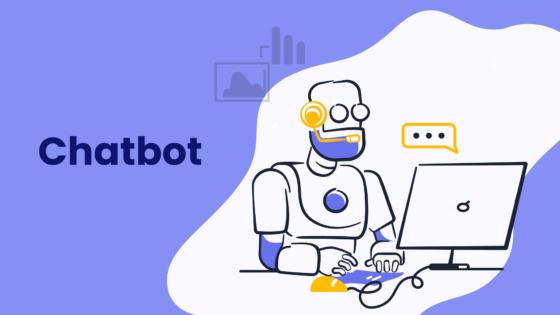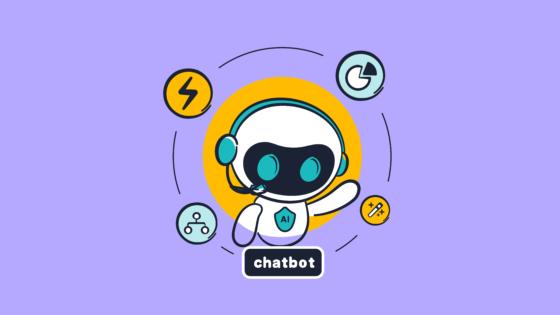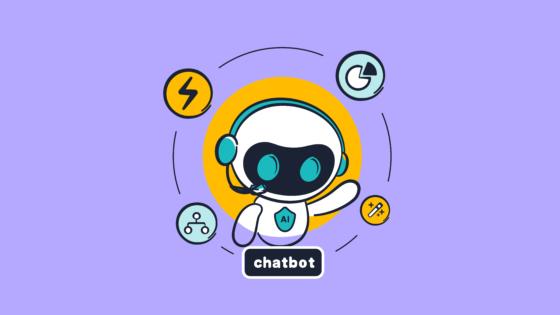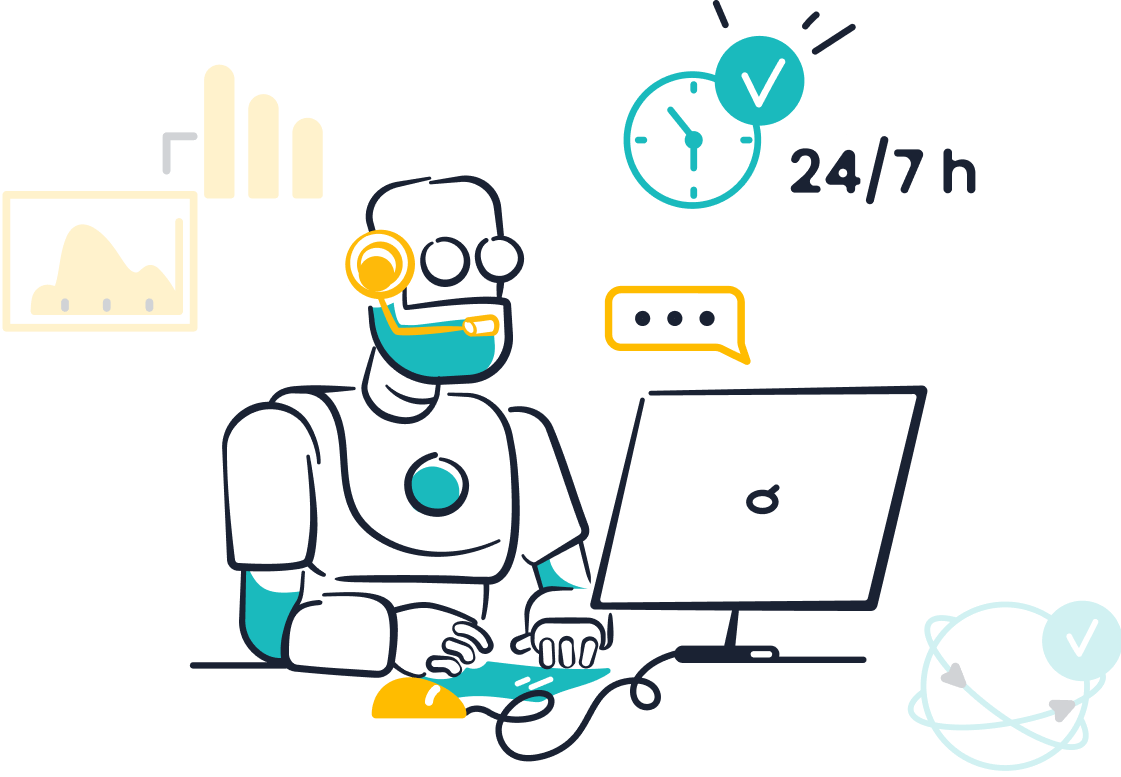Discover the Best Chatbot Solutions for Your Needs

In 2025, the best chatbot solutions are revolutionizing the way businesses connect with their customers. You can now provide seamless customer engagement, thanks to AI-driven chatbots that operate 24/7. Statistics reveal that 80% of users interacting with chatbots report positive experiences, while businesses using them achieve 20% higher customer satisfaction rates. These tools can handle up to 79% of routine inquiries, freeing up your team to focus on complex tasks. Companies like Sobot are leading this transformation, ensuring businesses deliver exceptional customer service while boosting efficiency. Chatbots are no longer a luxury—they are essential for staying competitive.
Quick Overview of the Best Chatbot Solutions in 2025

Top 5 Best Chatbot Software at a Glance
The chatbot market in 2025 is thriving, with several standout solutions offering advanced features and exceptional performance. Here are the top five chatbot software options that businesses trust for their customer engagement needs:

- Sobot Chatbot: Known for its powerful automation features, Sobot Chatbot delivers a seamless customer experience with 24/7 multilingual support and a no-code chatbot builder. It improves productivity by 70% and reduces costs by up to 50%.
- OpenAI's ChatGPT: This AI-powered chatbot excels in natural language understanding, making it ideal for handling complex queries and providing context-aware responses.
- Anthropic's Claude: Claude focuses on ethical AI, offering secure and reliable chatbot solutions tailored for industries with strict compliance requirements.
- Google's Bard: Bard integrates seamlessly with Google's ecosystem, providing businesses with a range of features like real-time analytics and audience segmentation.
- Intercom: Intercom combines live chat and AI chatbot capabilities, offering an easy-to-use interface for personalized customer interactions.
These solutions stand out for their ability to handle diverse business needs, from automating routine tasks to enhancing customer satisfaction.
Key Features That Define the Best AI Chatbot Software
The best AI chatbot software in 2025 shares several defining features that set them apart from the competition. These features ensure efficiency, scalability, and a superior customer experience:
| Feature | Description |
|---|---|
| AI-Powered Chatbots | Automates conversations, qualifies leads, and schedules meetings for immediate customer responses. |
| Live Chat | Enables real-time communication for a personalized customer experience. |
| No-Code Bot Building | Allows creation of chatbots without programming skills using a drag-and-drop interface. |
| CRM Integrations | Facilitates integration with CRM systems for streamlined workflows. |
| Analytics and Reporting | Provides tools to measure performance metrics and make data-driven decisions. |
| Multilingual Support | Ensures seamless communication with customers in their preferred language. |
| Omnichannel Support | Allows interaction across multiple platforms like WhatsApp, SMS, and social media. |
These features empower businesses to deliver efficient and personalized customer service while optimizing operational workflows. For example, AI-powered chatbots have been shown to save up to 70% in customer service expenses and improve response times by 80%.
Why Sobot Chatbot Stands Out in Customer Experience
Sobot Chatbot has emerged as a leader in the chatbot industry, offering a comprehensive solution that enhances customer satisfaction and operational efficiency. Its unique combination of features and performance metrics makes it a top choice for businesses.
| Metric | Value |
|---|---|
| Positive feedback rate | 96%+ |
| Customer satisfaction (CSAT) | 97% |
| Problem resolution rate | 85% |
| Customer happiness rate | 99% |
| Reduction in inbound discussion | 20% |
Sobot Chatbot's ability to deliver a 97% customer satisfaction rate highlights its effectiveness in meeting user needs. Its no-code chatbot builder and easy-to-use interface allow businesses to deploy AI-driven automation quickly. Additionally, its omnichannel and multilingual support ensures seamless customer engagement across platforms. By integrating advanced analytics and reporting, Sobot Chatbot helps businesses track performance and optimize their strategies.
With a 14-day free trial, Sobot Chatbot provides an excellent opportunity for businesses to experience its capabilities firsthand. Its proven track record, including a 57% increase in repurchase rates for clients like OPPO, demonstrates its value in driving customer engagement and loyalty.
Understanding Chatbot Software and Its Benefits
What Is Chatbot Software? A Comprehensive Definition
Chatbot software is a program designed to simulate human-like conversations through text or voice. It uses conversational AI to understand user intent, decipher context, and provide tailored responses. These tools are more than just customer service assistants. They can handle tasks like answering queries, recommending products, and troubleshooting issues. AI-powered chatbots operate 24/7, ensuring uninterrupted support and collecting valuable insights into customer behavior.
| Term | Definition |
|---|---|
| Conversational AI | A set of technologies enabling chatbots to communicate efficiently by understanding intent, language, and context, delivering human-like responses. |
| Chatbot | A software program that interacts with users through text or voice, offering solutions as if they were speaking to a real person. |
These tools have become essential for businesses aiming to enhance customer interactions and streamline operations.
Key Benefits of Using Chatbots for Customer Support
Chatbots bring numerous advantages to customer support. They improve efficiency by automating repetitive tasks, allowing your team to focus on complex issues. Here are some key benefits:
- 24/7 Availability: Chatbots provide round-the-clock support, ensuring customers always receive help when needed.
- Cost Savings: Automating customer support reduces the need for additional agents, cutting operational costs significantly.
- Faster Response Times: Chatbots eliminate wait times, offering instant solutions to customer queries.
- Improved Customer Satisfaction: Studies show that 69% of consumers appreciate chatbots for their quick responses and 64% value their availability.
- Scalability: Chatbots handle high volumes of inquiries simultaneously, making them ideal for businesses experiencing rapid growth.
For example, a motorcycle tire brand in Southeast Asia used a chatbot to provide 24/7 support, improving customer satisfaction by reducing delays. Similarly, an online banking provider found that their chatbot resolved 50% of inquiries, lowering operational costs.
Common Applications of Chatbots Across Industries
Chatbots are versatile tools with applications in various industries. Businesses use them to enhance customer engagement and streamline operations. Here are some common use cases:
- Retail and E-commerce: Chatbots assist customers with product recommendations, order tracking, and resolving post-sale issues.
- Education: Universities use chatbots to support students in learning new skills, such as improving English language proficiency.
- Finance: Banks deploy chatbots to answer account-related questions and guide users through transactions.
- Healthcare: Chatbots help patients schedule appointments and access medical information.
- Entertainment: Streaming platforms use chatbots to recommend content based on user preferences.
Research shows that the global AI chatbot market is projected to reach $27.2 billion by 2030. This growth highlights the increasing reliance on chatbots for quick, reliable, and personalized customer interactions.
In-Depth Reviews of the Best Chatbot Software
Sobot Chatbot: Features, Pricing, and Use Cases
Sobot Chatbot stands out as one of the best chatbot software options for businesses aiming to enhance customer service and operational efficiency. Its robust features include omnichannel support, multilingual capabilities, and a no-code chatbot builder. These tools allow you to create custom chat flows tailored to your business needs without requiring technical expertise. The chatbot operates 24/7, handling routine customer interactions and freeing your team to focus on complex tasks.
Sobot Chatbot delivers measurable results. For example, OPPO, a global smartphone leader, achieved an 83% chatbot resolution rate and a 57% increase in repurchase rates after implementing Sobot's solution. The chatbot also improves productivity by 70% and reduces costs by up to 50%.
Pricing for Sobot Chatbot is competitive, with flexible plans designed to accommodate businesses of all sizes. You can explore its capabilities with a 14-day free trial, making it easy to evaluate its impact on your customer support automation efforts.
OpenAI's ChatGPT: Features, Pricing, and Use Cases
OpenAI's ChatGPT excels in natural language understanding, making it a top choice for businesses requiring personalized customer interactions. Its advanced AI capabilities allow it to handle complex queries and provide context-aware responses. This makes it ideal for industries like education, healthcare, and finance, where detailed and accurate information is crucial.
ChatGPT's features include conversational AI, real-time learning, and integration with various platforms. However, its pricing can be steep for small businesses, especially those with high message volumes. Operational costs depend on usage, with processing 10,000 messages costing around $100 monthly. Despite this, its ability to deliver high-quality customer interactions often justifies the investment.
Anthropic's Claude: Features, Pricing, and Use Cases
Claude by Anthropic focuses on ethical AI, ensuring responsible and secure customer interactions. It is particularly suited for industries with strict compliance requirements, such as finance and healthcare. Claude's features include advanced LLM evaluation, which scored 90/100 for accuracy and relevance, and a perfect 100/100 for grounded responses.
Businesses using Claude benefit from its ability to categorize user intent and provide actionable insights. However, its reliance on ethical AI principles may limit its flexibility in certain scenarios. Pricing follows a pay-as-you-go model, with costs increasing based on usage. This structure makes it essential to monitor your message volume to optimize expenses.
Google's Bard: Features, Pricing, and Use Cases
Google's Bard is a powerful chatbot solution designed to enhance customer service and streamline operations. It integrates seamlessly with Google's ecosystem, making it a valuable tool for businesses already using Google Workspace. Bard stands out for its ability to provide real-time insights and personalized customer interactions.
Features
Bard offers a range of features that make it a top choice for businesses:
- Real-Time Analytics: Track customer interactions and measure performance instantly.
- Audience Segmentation: Group customers based on behavior for targeted communication.
- Multilingual Support: Communicate with customers in their preferred language.
- Omnichannel Integration: Connect with users across platforms like email, chat, and social media.
- AI-Powered Responses: Deliver accurate and context-aware replies to customer queries.
These features help businesses improve customer service and optimize their workflows.
Pricing
Google's Bard follows a subscription-based pricing model. Plans vary based on the number of users and the volume of interactions. While Bard offers competitive pricing, it may not include a 14-day free trial like some competitors. However, its integration with Google's tools often justifies the cost for businesses seeking a unified solution.
Use Cases
Bard is ideal for businesses in retail, finance, and education. Retailers use Bard to recommend products and track orders. Financial institutions rely on it for secure customer support automation. Educational organizations deploy Bard to assist students with course-related queries.
Intercom: Features, Pricing, and Use Cases
Intercom combines live chat and chatbot capabilities to deliver personalized customer service. Its user-friendly interface makes it accessible for businesses of all sizes. Intercom focuses on creating meaningful customer interactions through its innovative features.
Features
Intercom's features include:
- Live Chat Integration: Provide real-time support to customers.
- No-Code Bot Builder: Create custom chatbots without programming skills.
- CRM Integration: Sync customer data for seamless interactions.
- Proactive Messaging: Engage users with targeted messages.
- Analytics and Reporting: Gain insights into chatbot performance and customer satisfaction.
These features enable businesses to enhance customer service and drive engagement.
Pricing
Intercom offers flexible pricing plans based on the number of users and features required. While it does not provide a 14-day free trial, its scalable options make it suitable for startups and enterprises alike.
Use Cases
Intercom is widely used in SaaS, e-commerce, and healthcare. SaaS companies use it to onboard new users. E-commerce businesses rely on it for order tracking and product recommendations. Healthcare providers deploy Intercom to assist patients with appointment scheduling and inquiries.
Comparison Chart of the Best Chatbot Solutions

Side-by-Side Comparison of Features and Capabilities
When comparing chatbot solutions, you should focus on their range of features and how they align with your business needs. Below is a table summarizing the key features of the top chatbot software in 2025:
| Chatbot | Key Features | Unique Strength |
|---|---|---|
| Sobot Chatbot | Omnichannel support, multilingual capabilities, no-code chatbot builder, and 24/7 availability. | Powerful automation features that improve productivity by 70% and reduce costs by 50%. |
| OpenAI's ChatGPT | Advanced natural language understanding and context-aware responses. | Ideal for handling complex queries in industries like education and healthcare. |
| Anthropic's Claude | Ethical AI with secure, compliant interactions and advanced LLM evaluation. | Perfect for industries with strict compliance needs, such as finance and healthcare. |
| Google's Bard | Real-time analytics, audience segmentation, and seamless integration with Google Workspace. | Best for businesses already using Google's ecosystem. |
| Intercom | Live chat integration, proactive messaging, and an easy to use interface for personalized service. | Combines live chat and chatbot capabilities for enhanced customer engagement. |
This comparison highlights how each chatbot excels in specific areas, helping you identify the best fit for your business.
Pricing and Value for Money
Understanding pricing is crucial when selecting a chatbot. Each solution offers unique pricing models tailored to different budgets:
- Sobot Chatbot: Offers flexible plans for businesses of all sizes. You can start with a 14-day free trial to explore its capabilities. Its cost-effectiveness lies in reducing operational expenses by up to 50%.
- OpenAI's ChatGPT: Operates on a pay-as-you-go model. While it delivers high-quality interactions, its pricing may be steep for small businesses with high message volumes.
- Anthropic's Claude: Also follows a pay-as-you-go structure. Its focus on ethical AI ensures value for industries requiring secure and compliant solutions.
- Google's Bard: Uses a subscription-based model. Though it lacks a free trial, its integration with Google's tools often justifies the cost.
- Intercom: Provides scalable pricing plans. While it does not offer a free trial, its easy to use interface makes it accessible for startups and enterprises.
Each solution balances cost and value differently, allowing you to choose based on your budget and operational goals.
Best Fit for Different Business Sizes and Industries
Chatbots cater to diverse business needs, making them suitable for various industries and organization sizes. Here's how they align:
- Small Businesses: Intercom and Sobot Chatbot are excellent choices. Their easy to use interfaces and scalable features make them ideal for startups.
- Medium Enterprises: Google's Bard and OpenAI's ChatGPT provide robust tools for growing businesses. They handle complex queries and integrate seamlessly with existing systems.
- Large Enterprises: Sobot Chatbot and Anthropic's Claude dominate this segment. Their powerful automation features and compliance capabilities enhance operational efficiency.
Chatbots also serve multiple industries effectively:
- Retail and E-commerce: Sobot Chatbot excels in automating customer-facing interactions and boosting conversions.
- Healthcare: Anthropic's Claude ensures secure and compliant communication.
- Finance: OpenAI's ChatGPT and Sobot Chatbot streamline payment processing and account management.
By understanding your industry and business size, you can select a chatbot that meets your specific requirements.
How to Choose the Right Chatbot Solution for Your Business
Key Factors to Consider When Evaluating Chatbot Software
Choosing the right chatbot for your business requires careful evaluation of several factors. These considerations ensure that the solution aligns with your goals and delivers measurable results. Here are the key factors to keep in mind:
- Scalability: Select a chatbot that can grow with your business. Look for solutions with a proven track record of handling businesses of various sizes and offering tiered pricing options.
- Analytics and Data Insights: A chatbot should provide detailed analytics to help you understand user behavior and improve performance. Features like reporting on response times and user satisfaction scores are essential.
- User-Friendly Design: The chatbot interface should be intuitive and easy to navigate. Consistent branding and clear workflows enhance the user experience.
- Security and Compliance: Verify that the chatbot meets industry standards for data protection. Features like GDPR compliance and data encryption are critical for safeguarding customer information.
- Vendor Reputation and Support: Research the provider’s reputation. Check if they offer robust support for implementation and ongoing maintenance.
Tip: Tailor your evaluation metrics to your specific needs. Frameworks like Prompt Flow, Weights & Biases, and DeepEval can help you assess chatbot performance effectively.
Questions to Ask Before Selecting a Chatbot Solution
Asking the right questions can help you identify the best chatbot solution for your business. These questions will guide you in evaluating whether a chatbot meets your requirements:
-
What are your business goals?
Determine what problems the chatbot will solve. For example, do you want to improve customer service, boost sales, or reduce operational costs? -
Who is your target audience?
Understand who will interact with the chatbot. Consider their preferences, languages, and the platforms they use most frequently. -
How will the chatbot integrate with your current systems?
Assess your existing customer service setup. Ensure the chatbot can seamlessly connect with tools like CRM systems and communication platforms. -
What features are essential for your business?
Identify the must-have features, such as multilingual support, omnichannel capabilities, or advanced analytics. -
What is the vendor’s track record?
Research the provider’s experience and success stories. For instance, HelloFresh’s Freddy chatbot reduced response times by 76%, while Kofax’s KoBot achieved an 80% success rate in resolving queries.
| Company | Chatbot Name | Type | Benefits | Challenges | Lessons Learned |
|---|---|---|---|---|---|
| HelloFresh | Freddy | Off-the-shelf | Reduced response time by 76%, increased engagement by 47% | Limited conversational capabilities | Efficiency gains and scope limitations |
| Kofax | Kofax Support KoBot | Custom | 80% success rate in resolving queries, reduced support tickets | Development time required | Advanced NLP capabilities and long-term investment |
Tips for Testing and Implementing Chatbot Software
Testing and implementing a chatbot requires a structured approach to ensure success. Follow these tips to make the process smooth and effective:
-
Start with a Pilot Program
Test the chatbot in a controlled environment before a full-scale launch. This allows you to identify and fix any issues early. -
Use Real-World Scenarios
Simulate actual customer interactions during testing. This helps you evaluate the chatbot’s ability to handle queries accurately and efficiently. -
Monitor Key Metrics
Track performance metrics like response times, resolution rates, and user satisfaction. These insights will help you optimize the chatbot’s performance. -
Train Your Team
Provide training sessions for your staff to familiarize them with the chatbot’s features. This ensures smooth collaboration between human agents and the chatbot. -
Continuously Optimize
Regularly update the chatbot based on user feedback and analytics. For example, analyzing documentation and implementing identical chatbots, as seen in studies comparing Microsoft Bot and Rasa, can reveal areas for improvement.
Note: A well-implemented chatbot can enhance your customer engagement strategy. It can also streamline operations and improve overall efficiency.
Choosing the right chatbot software plays a vital role in improving customer satisfaction and operational efficiency. It helps you deliver a seamless customer experience while optimizing your resources. The reviewed options, including Sobot Chatbot, offer powerful tools to meet your business needs. Take the next step by exploring these solutions and testing their features. Implementing the right chatbot can transform your customer interactions and drive long-term success. Start your journey today and see the difference it makes.
FAQ
What is the main purpose of a chatbot?
A chatbot automates conversations with users. It answers questions, provides recommendations, and resolves issues. Its primary goal is to improve customer experience while reducing the workload on human agents. Chatbots also operate 24/7, ensuring uninterrupted support.
How do chatbots save businesses money?
Chatbots handle repetitive tasks, reducing the need for additional staff. They triage queries, cutting operational costs by up to 50%. For example, Sobot Chatbot operates around the clock, solving routine inquiries without requiring human intervention.
Can chatbots work across multiple platforms?
Yes, modern chatbots offer omnichannel support. They interact with customers on platforms like WhatsApp, SMS, email, and social media. Sobot Chatbot, for instance, ensures seamless communication across all these channels, enhancing customer engagement.
Do I need coding skills to set up a chatbot?
No, many chatbots, including Sobot Chatbot, feature no-code builders. You can design workflows using drag-and-drop tools. This makes chatbot setup accessible even if you lack technical expertise.
How do chatbots improve customer satisfaction?
Chatbots provide instant responses, reducing wait times. They offer personalized interactions by understanding user intent. Features like multilingual support and 24/7 availability ensure customers feel valued and supported, leading to higher satisfaction rates.
See Also
Essential Tips for Selecting Top Chatbot Solutions
Best 10 Chatbot Options for Websites This Year
Simple Steps to Effectively Use Chatbots on Websites